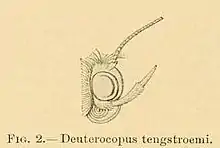| Deuterocopus tengstroemi | |
|---|---|
 | |
| Deuterocopus tengstroemi Zeller, 1852, Natural History Museum specimen NHMUK 010919173 | |
 | |
| Scientific classification | |
| Kingdom: | |
| Phylum: | |
| Class: | |
| Order: | |
| Family: | |
| Genus: | |
| Species: | D. tengstroemi |
| Binomial name | |
| Deuterocopus tengstroemi Zeller, 1852 | |
Deuterocopus tengstroemi is a moth of the family Pterophoridae. It is known from Java and Queensland, Australia.
Larvae have been recorded feeding on Vitis quadrangularis.
Original description
(wingspan female 12 mm) Palpi long, slender, semi-erect, pale-ferruginous; second joint very slightly dilated at apex, where it is banded with dark-ferruginous; third joint slightly over half length of second, acuminate, broadly banded with dark-ferruginous at base and apex. Antennae dark-ferruginous, dotted with whitish above. Head light-ferruginous, top of crown with long anteriorly-erected scales. Thorax light-ferruginous; pectus marked with whitish. Abdomen stout, light-ferruginous with traces of whitish submedian spots on second segment, and of a narrow transverse white band along posterior edge of third segment; ventral surface white, mottled on sides with ferruginous-golden, fourth segment margined posteriorly with ferruginous-golden. Foreleg whitish-ferruginous, tibia with apical scale-tuft of darker ferruginous scales (but no "white spines"). Midleg whitish-ferruginous, tibia with apical scale-tuft of darker-ferruginous scales (spurs broken). [Hindlegs missing.] Forewing cleft from rather within 3/5, first segment moderately broad with slight hinder-angle, second segment expanded posteriorly and again cleft to one-half of its own length, subsegments linear, first parallel to first segment, divergent from second: bright ferruginous-golden slightly suffused with light ferruginous: first segment lightly suffused with ferruginous except on costa at 1/4 length of segment, cut at about 2/3 by a nearly obsolete inwardly-oblique whitish line ; second segment lightly suffused with ferruginous, first subsegment with a minute whitish dot near base. Cilia on costa light-ferruginous, slightly darker on base of first segment, on first segment black at 2/5 as a slight bar, with slight blackish admixture at 3/5 and 4/5; at apex black; on hinder-margin of first segment whitish-ochreous from 2/3 to immediately before hinder-angle blackish-ferruginous, a hinder-angle a small blackish wisp preceded by a very narrow ferruginous wisp, on termen pale-ferruginous with a blackish basal line; on fore-margin of second segment whitish-ochreous, beyond 3/4 blackish-ferruginous, at apex of first subsegment wliitish-ocbreous with a broad blackish basal line surrounding apex of subsegment and forming a very small posteriorly-directed scale-tooth; on hinder-margin of first subsegment dark-ferruginous to 1/2, beyond 1/2 whitish-ochreous; on fore-margin of second subsegment dark-ferruginous to 1/2, beyond 1/2 blackish; at apex of second subsegment whitish-ochreous with a black basal line produced into a small posteriorly-directed tornal scale-tooth; on dorsum whitish-ochreous, a small blackish wisp beneath base of second cleft, cilia beyond this darker. Hindwing cleft from about 3/5 and from near base, segments linear; bright ferruginous-golden slightly suffused with light-ferruginous. Cilia whitish-ochreous; third segment with a large apical blackish-ferruginous scale-tooth on both margins, a few small scattered black scales on fore-margin, and a small blackish tooth on dorsum sliglitly before 1/2. Habitat. Zeller's original specimens, one of which I have examined, were from Java. The only other examples which I have seen are two from Queensland in Lord Walsingham's collection, one from Cedar Bay (Meek, 1894), the other - very worn and possibly not really tengstroemi, its condition making its identification doubtful - from Geraldton, near Cairns (Meek, 1894).
— Original re-description by T.B. Fletcher
External links